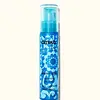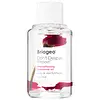What's inside
What's inside
 Key Ingredients
Key Ingredients

 Benefits
Benefits

 Concerns
Concerns

 Ingredients Side-by-side
Ingredients Side-by-side

Prunus Amygdalus Dulcis Oil
Skin ConditioningRicinus Communis Seed Oil
MaskingMangifera Indica Seed Butter
Skin ConditioningSimmondsia Chinensis Seed Oil
EmollientSqualane
EmollientLauryl Laurate
Skin ConditioningArgania Spinosa Kernel Oil
EmollientHippophae Rhamnoides Fruit/Seed Oil
AntimicrobialBrassica Campestris Seed Oil
Skin ConditioningSesamum Indicum Seed Oil
EmollientCocos Nucifera Oil
MaskingSodium Hyaluronate
HumectantSpirulina Platensis Extract
Skin ProtectingEmblica Officinalis Fruit Extract
Skin ConditioningCurcuma Longa Root Extract
MaskingOryza Sativa Bran Extract
Skin ConditioningRosmarinus Officinalis Leaf Extract
AntimicrobialHelianthus Annuus Extract
EmollientGlycerin
HumectantPEG-8 Caprylic/Capric Glycerides
EmulsifyingOctyldodeceth-25
CleansingWater
Skin ConditioningCocos Nucifera Water
MaskingTocopherol
AntioxidantPhenoxyethanol
PreservativePropylene Glycol
HumectantDecylene Glycol
Skin ConditioningParfum
MaskingPrunus Amygdalus Dulcis Oil, Ricinus Communis Seed Oil, Mangifera Indica Seed Butter, Simmondsia Chinensis Seed Oil, Squalane, Lauryl Laurate, Argania Spinosa Kernel Oil, Hippophae Rhamnoides Fruit/Seed Oil, Brassica Campestris Seed Oil, Sesamum Indicum Seed Oil, Cocos Nucifera Oil, Sodium Hyaluronate, Spirulina Platensis Extract, Emblica Officinalis Fruit Extract, Curcuma Longa Root Extract, Oryza Sativa Bran Extract, Rosmarinus Officinalis Leaf Extract, Helianthus Annuus Extract, Glycerin, PEG-8 Caprylic/Capric Glycerides, Octyldodeceth-25, Water, Cocos Nucifera Water, Tocopherol, Phenoxyethanol, Propylene Glycol, Decylene Glycol, Parfum
Caprylic/Capric Triglyceride
MaskingHydrogenated Castor Oil/Sebacic Acid Copolymer
EmollientEthyl Macadamiate
Skin ConditioningRose Flower Oil
MaskingCeramide NP
Skin ConditioningSqualane
EmollientRose Extract
Skin ConditioningFragaria Ananassa Seed Oil
AntioxidantPrunus Amygdalus Dulcis Oil
Skin ConditioningUndaria Pinnatifida Extract
Skin ConditioningSantalum Album Oil
MaskingAmyris Balsamifera Bark Oil
MaskingPogostemon Cablin Leaf Oil
MaskingElettaria Cardamomum Seed Oil
MaskingFerula Galbaniflua Resin Oil
AntimicrobialPanthenol
Skin ConditioningRosa Canina Fruit Oil
EmollientHydrolyzed Hyaluronic Acid
HumectantPrunus Domestica Seed Oil
Skin ConditioningTocopheryl Acetate
AntioxidantDicaprylyl Ether
Emollient1,2-Hexanediol
Skin ConditioningDicaprylyl Carbonate
EmollientMalic Acid
BufferingTocopherol
AntioxidantParfum
MaskingCaprylic/Capric Triglyceride, Hydrogenated Castor Oil/Sebacic Acid Copolymer, Ethyl Macadamiate, Rose Flower Oil, Ceramide NP, Squalane, Rose Extract, Fragaria Ananassa Seed Oil, Prunus Amygdalus Dulcis Oil, Undaria Pinnatifida Extract, Santalum Album Oil, Amyris Balsamifera Bark Oil, Pogostemon Cablin Leaf Oil, Elettaria Cardamomum Seed Oil, Ferula Galbaniflua Resin Oil, Panthenol, Rosa Canina Fruit Oil, Hydrolyzed Hyaluronic Acid, Prunus Domestica Seed Oil, Tocopheryl Acetate, Dicaprylyl Ether, 1,2-Hexanediol, Dicaprylyl Carbonate, Malic Acid, Tocopherol, Parfum
 Reviews
Reviews

Alternatives
Ingredients Explained
These ingredients are found in both products.
Ingredients higher up in an ingredient list are typically present in a larger amount.
Parfum is a catch-all term for an ingredient or more that is used to give a scent to products.
Also called "fragrance", this ingredient can be a blend of hundreds of chemicals or plant oils. This means every product with "fragrance" or "parfum" in the ingredients list is a different mixture.
For instance, Habanolide is a proprietary trade name for a specific aroma chemical. When used as a fragrance ingredient in cosmetics, most aroma chemicals fall under the broad labeling category of “FRAGRANCE” or “PARFUM” according to EU and US regulations.
The term 'parfum' or 'fragrance' is not regulated in many countries. In many cases, it is up to the brand to define this term.
For instance, many brands choose to label themselves as "fragrance-free" because they are not using synthetic fragrances. However, their products may still contain ingredients such as essential oils that are considered a fragrance by INCI standards.
One example is Calendula flower extract. Calendula is an essential oil that still imparts a scent or 'fragrance'.
Depending on the blend, the ingredients in the mixture can cause allergies and sensitivities on the skin. Some ingredients that are known EU allergens include linalool and citronellol.
Parfum can also be used to mask or cover an unpleasant scent.
The bottom line is: not all fragrances/parfum/ingredients are created equally. If you are worried about fragrances, we recommend taking a closer look at an ingredient. And of course, we always recommend speaking with a professional.
Learn more about ParfumPrunus Amygdalus Dulcis Oil comes from the sweet almond, a tree native to Iran. This oil has no fragrance and is non-volatile.
Almonds contain healthy fats, vitamins, and minerals. It is a rich source of Vitamin E, a great antioxidant and skin conditioning ingredient. Sweet almond oil contains fatty acids such as linolenic acid and triglycerides.
The content of sweet almond oil makes it a great emollient; it can help soften and hydrate your skin. Emollients create a barrier over your skin to trap moisture in. Sweet almond oil has antioxidant properties.
Those with an almond allergy should be careful of this ingredient and speak with a professional about using it in your skincare.
This ingredient may not be fungal-acne safe.
Learn more about Prunus Amygdalus Dulcis OilSqualane is an emollient that helps the skin hold onto moisture. It's an oily liquid that occurs naturally in certain types of fish and plant oils.
Because squalane boosts hydration in the skin, it also comes with plenty of benefits: it is an antioxidant and can help fight free radicals and skin damage. Squalane is also found to have a detoxifying effect when applied.
Squalane comes from squalene, which occurs naturally within the sebum of our skin. It is one of the oils our skin produces to keep itself hydrated. Squalane is the hydrogenated version of squalene and has a longer shelf life.
Research shows that squalane is non-irritating (even at 100% concentration).
In general, it's a fantastic ingredient. It does a great job at hydrating the skin, and it's suitable for those with sensitive skin.
The source of squalane may impact malassezia / fungal acne. This is because olive oil derived squalane can contain impurities such as fatty acids and plant waxes. Sugarcane derived squalane is recommended for anyone with malassezia concerns.
Is squalane vegan?
This depends on the source. Squalane can be derived from both plants and animals. Most squalane used in skincare comes from plants.
Please note: the source of squalane is only known if disclosed by the brand. We recommend reaching out to the brand if you have any questions about their squalane.
Read more about squalene with an "e".
Is squalane an oil?
Squalane is often called an oil, but it’s technically not; it’s a hydrocarbon, meaning it’s only made of carbon and hydrogen, unlike true oils which are triglycerides made of fatty acids and glycerol.
The term “oil-free” isn’t regulated, so companies can define it however they want. Some exclude all oils, while others just avoid mineral oil or comedogenic oils.
While some people avoid oils thinking they cause breakouts, the right kind of oil (or oil-like ingredient like squalane) can actually help balance and hydrate your skin. It’s worth testing out simple oils or squalane to see what works best for your skin.
Learn more about SqualaneTocopherol (also known as Vitamin E) is a common antioxidant used to help protect the skin from free-radicals and strengthen the skin barrier. It's also fat soluble - this means our skin is great at absorbing it.
Vitamin E also helps keep your natural skin lipids healthy. Your lipid skin barrier naturally consists of lipids, ceramides, and fatty acids. Vitamin E offers extra protection for your skin’s lipid barrier, keeping your skin healthy and nourished.
Another benefit is a bit of UV protection. Vitamin E helps reduce the damage caused by UVB rays. (It should not replace your sunscreen). Combining it with Vitamin C can decrease sunburned cells and hyperpigmentation after UV exposure.
You might have noticed Vitamin E + C often paired together. This is because it is great at stabilizing Vitamin C. Using the two together helps increase the effectiveness of both ingredients.
There are often claims that Vitamin E can reduce/prevent scarring, but these claims haven't been confirmed by scientific research.
Learn more about Tocopherol